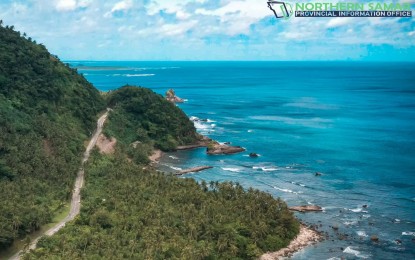
STRATEGIC LOCATION. A portion of the Pacific coast of Northern Samar. The Board of Investments (BOI) is upbeat about making Northern Samar province as a destination for strategic investments in the Visayas, a key official said on April 17, 2024. (Photo courtesy of Northern Samar provincial information office)
TACLOBAN CITY – The Board of Investments (BOI) is upbeat about making Northern Samar province as a destination for strategic investments in the Visayas, a key official said on Wednesday.
In a press briefing here, BOI Director Ernesto Delos Reyes Jr. said Northern Samar is very close to Luzon and a gateway to the Visayas through land transport.
“Northern Samar has the potential because of its strategic locations. It’s time to bring in big investments here. The province is rich in natural resources, it has a young and talented workforce, and its location is strategic,” Delos Reyes told reporters.
Some ports in Northern Samar form part of the nautical highway that connects Luzon to Visayas and Mindanao.
Roll-on and roll-off ferries have been crossing the San Bernardino Strait, carrying passengers and vehicles to and from Allen Port and Matnog Port in Sorsogon.
The official lauded the province as the first local government in the country to establish the green lane.
Green Lane, officially known as the Northern Samar One-Stop-Action Center for Strategic Investment, is a new process that seeks to streamline the process of obtaining business permits and licenses in the province.
The provincial government set up the green lane in January this year, or two months before the issuance of implementing rules and regulations last March, according to Delos Reyes.
Under the green lane, business permits and licenses at the town and village levels are obtained by having one point of transaction through the provincial capitol.
“The primary concern of our big investors is not really tax incentives but the hassle-free processing of permits and licenses,” he added.
Since the operation of this one-stop shop at the capitol in Catarman town, the province has already drawn two major investments: the common cell sites project by Philtower Consortium and the PHP108 billion offshore wind power project by Copenhagen Infrastructure Partners and Aboitiz Infrastructure.
PhilTower has not yet disclosed its investments. However, it is planning to build 100 common cell sites in Northern Samar.
The upcoming project is the tidal energy project by Energies PH Inc., the first of its kind in the Philippines and Southeast Asia.
The green lanes for strategic investments were established through Executive Order No. 18, which was approved by the Office of the President in February last year.
Governor Edwin Ongchuan said fast-tracking the process of permit applications for strategic investment is their top priority.
“Major investors don’t have to talk to many local government officials. Processing can be done at the provincial government level,” Ongchuan said.
The governor lauded President Ferdinand Marcos Jr. for approving major infrastructure projects such as the PHP7.4-billion Samar Pacific Coastal Road (SPCR) 2 Project, which will enhance access from some towns to roads leading to the airport.
“Through years of efforts, insurgency has been eradicated in Northern Samar, and investors took a second look for opportunities,” he added.
Meanwhile, John Allen Berbon, chief of the Northern Samar provincial economic development and investment promotion office, said they are working on developing the Comprehensive Land Use Plan (CLUP) for all 24 towns in the province.
“Investors always look for CLUP because they want to build structures in the right place. At least six out of 24 towns have approved CLUP. The governor ordered to assist local government units to craft their respective CLUPs,” Berbon said.
A CLUP refers to the document formulated by the local government in consultation with its stakeholders defining or providing guidelines on the allocation, utilization, development, and management of all lands within a given territory or jurisdiction, including municipal waters. (PNA)
